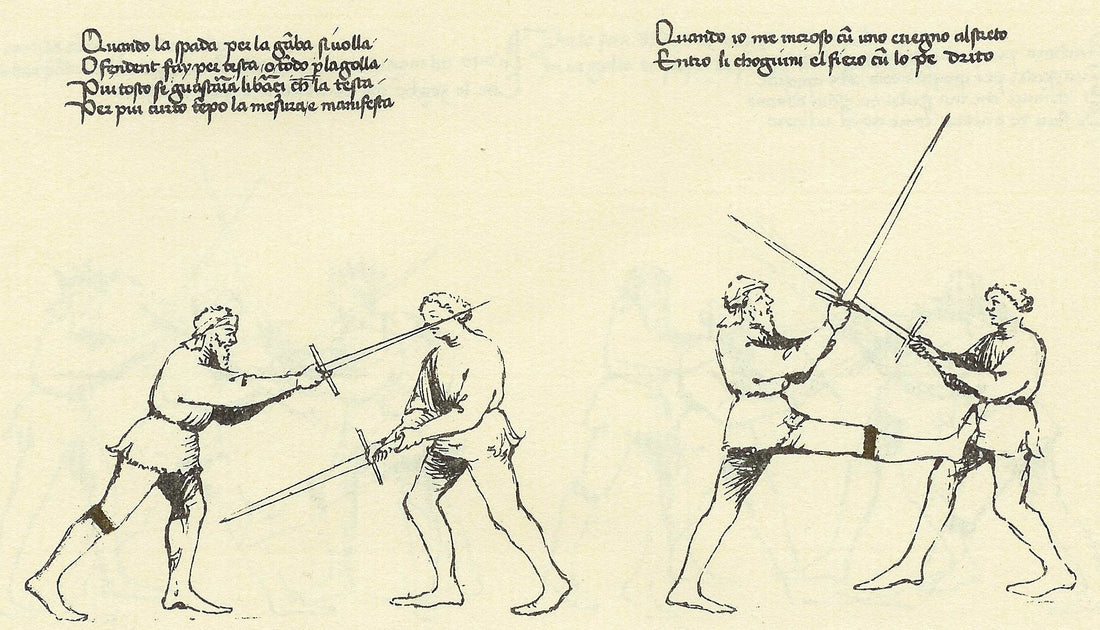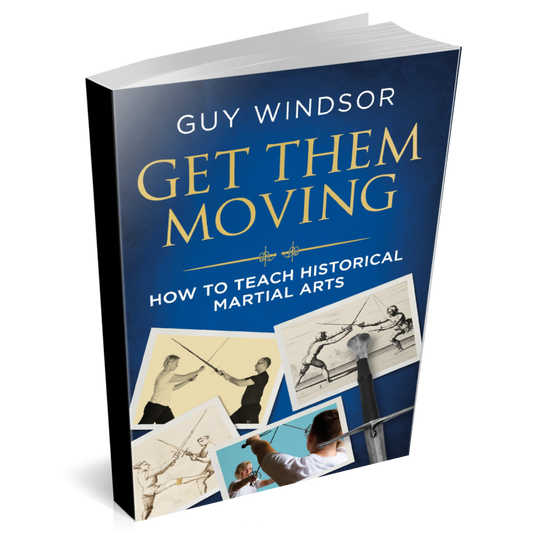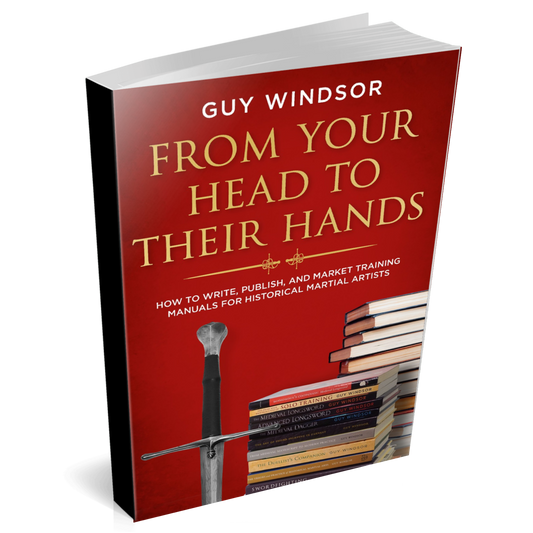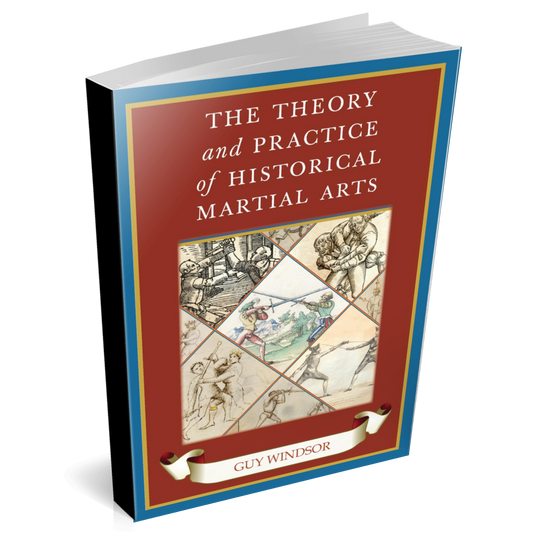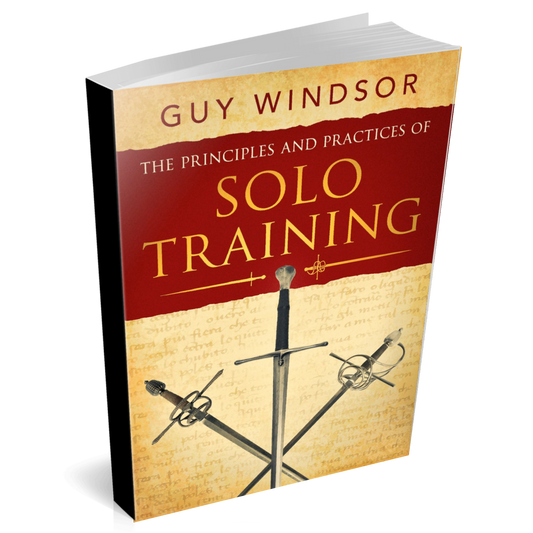You can also support the show at Patreon.com/TheSwordGuy Patrons get access to the episode transcriptions as they are produced, the opportunity to suggest questions for upcoming guests, and even some outtakes from the interviews. Join us!
Your challenge for November is to improve your striking. Really, what we are looking at more than anything else is your precision and accuracy, which you can apply to any domain. Someone who drives a car might look at the smoothness of their gear changes, or the precision with which they take a corner. There is no domain in life that this cannot be applied to. Of course, as sword people, we will tend to apply it to swords first, but it is no bad thing to let it leak out into other areas of your life.
Whether you are striking with a fist, a foot, a stick, or a sword, there are fundamental components in common. I’ll cover these in this episode, along with ideas for training, equipment you can utilise, and the use of forms.
The bulk of this episode is taken from my book, The Windsor Method: The Principles of Solo Training, which is available to buy now.
For all the other monthly challenges so far this year, head over to the Challenge of the Month category of my blog. We have covered topics including sleep, getting stronger and more flexible, meditation and more.
Transcript
Your challenge this month is to strike better. To quote from The Windsor Method:
Whether you are striking with a fist, a foot, a stick, or a sword, there are fundamental components in common. They are:
- Mechanics: are you moving correctly?
- Accuracy: can you hit the right target? Many combat sports have restricted target areas, and the difference between putting your sword on someone’s breastplate or in the gap between breastplate and pauldron is critical. This includes hitting with the correct part of the weapon. A cut with the edge works much better than a cut with the flat. Punch incorrectly and you can break your own bones.
- Power: can you hit hard enough to get the desired effect? That may be to trigger an electric circuit (in modern fencing), to knock them out (in boxing), or even to slice off a body part (in a medieval duel).
- Control: can you handle the power you are generating? Over-commitment can lead to catastrophic outcomes. You could injure your training partners, or leave yourself open to a counter, if your weapons are not under your control.
- Timing: can you execute your controlled, accurate, powerful strike at the right time? In general we aim to strike into an open or opening line.
- Measure: can you execute your perfectly timed, controlled, accurate, and powerful strike from the right place- not too close, not too far away?
We can develop all these skills alone, though both timing and measure are easier to practise with a partner or coach.
With weapons training we usually begin with handling drills, designed to give us fluent control over the weapon. Unarmed equivalents include shadow boxing and working combinations of strikes to develop an unconscious control over whichever parts of your body you hit with.
Mechanics: grounding and initiation
The mechanics of movement are covered by the sciences of kinematics (the study of the geometry of motion), and kinetics (the study of the forces involved). For our purposes, we can consider them as analogous to grounding (the structures in play) and initiation (how those structures are moving).
Grounding
Grounding is the process of taking incoming force and routing it through your skeleton into the ground without interference from you. In a perfect world in whatever position you’re in, there’s a groundpath where force coming back from your weapon or in from your opponent is routed through a passive structure of bones directly into the ground. (Oh my, there is a whole other book in this one idea. I’ll get on with it shortly.) There are about 200 bones in your body, and about 600 muscles. The question to ask yourself is, “is every bone in the right place, and does every muscle have the right degree of tension?”
Initiation
As I mentioned in the Footwork chapter, initiation describes the order in which the various parts of your body moves. For most weapons work, the feeling should be that the weapon moves, dragging your body behind it into the correct posture. Most punches should begin in the fist. But, there are trade-offs. A punch that goes fist-shoulder-hip-leg will be very fast, but hit less hard than one that goes leg-hip-shoulder-fist. I find it helpful to consider three main centres of initiation. A strike begins in the hand, the hip (or waist, as t’ai chi people will say), or the leg.
We can also consider centres of rotation – a motion that is centred in the shoulder is different from one centred in the elbow. With sword motions, the sword can rotate around the point, the middle of the blade, the centre of balance, the forefinger, the wrist, the elbow, the shoulder, the hips, or the feet. (Usually. There are other options.) A motion that begins with a rotation in the middle of the sword might include rotation in the forefinger, elbow, shoulder, hip and foot (usually in that order).
Different arts prioritise different centres, for perfectly good reasons, and different strikes will have different optimal initiation patterns. The question to ask yourself is, “am I starting the movement in the right place?”
Tools for striking practice
The tools you need for striking practice are mostly variations on the idea of the target. They include targets you can hit hard (such as a heavy punching bag for unarmed work, a tyre for armed work), targets you can actually destroy (such as tatami mats for cutting with sharp swords), targets that give you feedback on your accuracy (such as point control wall targets), and targets that move, which help you with timing and measure. I should also mention here dummies for wrestlers, which serve the same function of giving useful feedback about technical accuracy.
As swordsmanship is my primary martial art, I’ll stick to what I know and discuss the tools we use; I’m sure you can come up with useful variations for whatever art you practise.
One of the core skills of using a sword is getting the point to go where you want it to. The principal tools we use for this are the wall target, the pell, the tyre, and the buckler game.
The Wall Target
The wall target is a padded striking surface for thrusting at. We know that these have been in use since at least the late sixteenth century, when a primarily thrust-oriented style of fencing became common. I use it with every weapon.
I made my own target out of a piece of plywood covered with camping mat foam and a layer of leather. Additional leather patches to reinforce the target points are a good idea. Wall targets should be large enough that you are never likely to miss the target altogether; holes in the wall are hard to explain. The main school target has three main striking points, approximately at face, heart and groin height (for an opponent standing on guard), with two additional points placed like eyes. There is enough space around the target for all footwork actions, for both left- and right-handers.
For any thrust-oriented weapon this is perhaps the most important solo practice you can do: in addition to accuracy, it teaches you distance, power, and control. Make sure before you start that your blade is designed to take the repeated bending, and if you are using a triangular section blade, make sure that the point of the triangle is in the inside of the curve. Symmetrically cross-sectioned blades (such as the common lozenge shape) can bend in both directions. Regular practice on the wall makes up about 80 per cent of my own rapier, smallsword, and foil training. It is very important that the blade bends when the point touches the wall, but there is no “give” anywhere else. Ensure that the blade stays in line with your forearm, and your wrist locks to support the pressure.
The purpose of the lunge is to drive the sword through the target. With a practice blade and a wall target, the energy is absorbed by the blade; with a sharp blade and a penetrable target, that energy is used to puncture the target.
The sword/swordsman combination should be perfectly aligned so that no energy “leaks.” The lunge is the perfect long attack with all your weight and energy focussed in one direction, on one point.
The Pell
The pell is a post, often with a crossbeam, fixed upright for you to cut and thrust at. Try the following exercises:
- Pick one blow, and see how hard and fast you can strike at the pell without touching
- Repeat with multiple strikes (use your imagination!) Strike fast, but stroke the pell gently on a marked spot (about as hard as you would like to be hit in freeplay). See how hard and fast that really is
- Repeat with multiple strikes in different lines
- Choose a specific strike, and approach the pell from far away, moving smoothly and without stopping with blows from guard to guard: see if you can arrive in measure with your sword in the right place to launch the pre-arranged strike. This is harder than it sounds.
- The 99 strikes exercise: Make 100 cuts at the pell, without touching it. Every time you touch it, the counter resets to zero. So if you touch on strike 99, you go back to the beginning …
The Tyre
An ordinary car tyre, held by a helpful partner, is an ideal striking target as it absorbs some, but not all, of the impact. You can hit it with absolutely full-force without endangering the person holding it (unless you miss), and while it gives some shock back into the sword and your hands, much of the force is taken by the elastic give of the tyre. Every target hits back- every action has an equal and opposite reaction. If your technique is correct, you can direct the returning energy down into the ground. If not, the tyre will bounce your sword up and off. I recommend adding a strip of duct tape as a more precise aiming point. When you hit the tyre, the energy going into it should be absorbed by the tyre (and your partner). You should feel almost nothing. Start gently, standing still, and work your way up adding speed and power slowly. Then try adding footwork, such as striking with a pass.
Your body knows that to hit hard, it should step first, and strike with the rotation of the hips. This will give you maximum power, but get you killed in a sword fight. It is critically important to remember that the tyre is not waiting with a sword to kill you, and therefore will let you get away with wildly incorrect timing – you can step into measure and then strike. You need to watch for this – I suggest setting up the video camera and checking your form regularly.
The Buckler Game
Strictly speaking this exercise doesn’t belong in a book about Solo Training, because it requires a partner. But, it only requires a willing friend, not a fellow martial artist, and it’s too useful to leave out.
For this exercise we use a simple wooden buckler as a thrusting target. Your partner holds it in one hand (and wears a mask just in case), and offers it up for you to thrust at. Their job is then to make you move about, offering the target at various heights and distances, and for decreasing lengths of time, making it difficult for you to get the thrust in. This should be calibrated so that you can hit it about three to four times out of five attempts. Less than that, they should slow down; more than that, they should make things harder. This is just like using focus mitts with a boxing coach.
Cutting Targets
If your art includes cutting weapons, then you need to know how to actually cut. There are many options for cutting targets, and when designing the target we need to take the following things into account.
- Verisimilitude: how well does it simulate the “real” target?
- Cost: how much money and time does it take to prepare?
- Consistency: how similar can we make each target piece, to ensure minimum variations that might affect the resistance to cutting?
- Damage: will the target materials damage the sword and, if so, is that acceptable? Blood and water rust steel, bones can chip blades, straw scratches, etc.
The following targets seem popular in current HMA circles: Japanese-style mats (tatami omote) made from soft rush material; beach mats (used the same way as tatami – they’re cheaper but do more damage to the sword and are less consistent); animal parts; cardboard tubes; carpet rolls; dangling rope; plastic bottles filled with water; and rolls of newspaper. Paper products such as newsprint or cardboard can carry the abrasive grit used in the pulping process, which will scratch and may dull your sword. Given the range available, it makes sense to try out the ones suitable for your training environment. In each case the targets vary according to their weight, density, hardness, how much resistance the materials give to the blade (mats, rope and paper are usually soaked to lubricate the cut and soften the fibres; this also more closely simulates the conditions in the human body), and how stable the target is on impact. A dangling rope is much harder to cut than one held taut because it can move away from the cut. Likewise, the same rope is easier to cut with a downwards blow than a rising one. An empty plastic bottle standing on a level surface is harder to cut than the same bottle filled with water, because the weight of the water holds the bottle in place at the moment of impact. It is necessary that the target be cuttable by the sword in question: no sword should be used to cut down a tree (that’s why loggers used axes). Where armour is placed over the target (such as putting a gambeson sleeve over a leg of lamb), it is important to be clear whether it is the armour, the sword or the cut being tested. I have found that the tatami omote, though laborious to prepare and relatively expensive to obtain, are the most consistent and hence most useful cutting substrate.
The sharpness of the sword is also an issue. People who specialise in test cutting tend to prefer a very sharp edge, because it cuts better. However, practising technical drills with sharp swords teaches you first and foremost that during a sword fight a very sharp edge gets damaged worse and faster than a slightly dull one, and that any sword that can be considered sharp will incur damage to the edge on contact with another sword. Medieval combat styles often include half-sword technique, whereby the sword is grasped by handle and blade: a super-sharp edge makes this risky, but an ordinarily sharp sword will not cut the hand unless the blade is drawn across it. For cutting practice it is perfectly acceptable to use an over-sharp sword, provided that we take into account the excessive sharpness when estimating the blow’s effectiveness in combat.
It is not actually necessary to simulate a body part at all for the purposes of testing the effect of different styles of cut or testing changes to your cutting technique: any consistent target that is appropriate for cutting will do to start with. Careful examination of the target and the blow should tell you whether your cut is hitting (but not cutting) or whether it’s slicing through easily, how accurate the blow was, what part of the edge cuts best, how your footwork (if any) affects the blow, and how much effort the effect is costing you. Video taping the cutting session is extremely useful for those purposes, as is the presence of a competent instructor.
It is also worth setting up thrusting targets that you can stick with sharp blades. An old pillowcase stuffed with scraps of cloth can work, and I do thrust at tatami mats too. It’s generally less critical to practise thrusting with sharps because if your thrust works on the wall target with a blunt sword, it will work with sharps. The same is not true of cuts, due to the issues of edge alignment and slicing mechanics.
Training Forms
No discussion of Solo Training would be complete without mentioning forms. Some arts, such as t’ai chi, are very much based on a form. Others, such as the Bolognese swordsmanship of the 16th century, use forms as training tools but don’t prioritise them in the same way. Most arts have forms of one kind or another. Forms come in all shapes and sizes, and have a variety of different purposes.
It helps to know how forms are created in order to use them efficiently. Any form has, at least, the following elements.
- Techniques: the heart of the Art itself.
- Attribute training exercises: technical studies intended to generate specific skills or strengths, such as jumps for leg strength, handling drills for weapons, and all sorts of things that you wouldn’t use in a fight but which make you a better martial artist.
- Connecting steps: steps included to make the pattern of the Form coherent and repeatable, or to make it fit into the available training space.
The purpose of the form determines its content. The question “What is it For?” has many possible answers, which include:
- Self-Improvement.
- Memory Guide. The Form should make it easier for students to recall aspects of the Art in question.
- Flow/Mechanics. Practising the Form should ingrain the correct movement style and habits, enabling fluent and powerful actions.
- Expandable zip file. The Form can be built in a way that allows the various actions to be expanded upon, to trigger memory cascades and to create loci for memorising other material.
Once you have the Form in memory, you can use it for all sorts of other things. One of my favourites is practising at multiple speeds.
- Treacle speed: go so slowly that every step is an exercise in hovering. This is really, really hard.
- Walking speed: this is the normal speed at which you will stroll through the Form, not rushing, but not too slow: a nice, comfortable pace.
- Fast: this is where it all goes to hell. Go as fast as you can. This should hurt – hurt not least your pride and your sense of aesthetics, when actions that were quite accurate suddenly get really sloppy.
- Continuously: put on some music (I usually use the Eye of the Tiger for this), start your Form when the music starts, and do not stop for any reason (except to prevent injury) until the music stops. You could just repeat the Form over and over, but I like to play with it.
The primary risk of Form training can be summarised as “it becomes ballet”. Compliant opponents allow your technique to become sloppy: form replaces function. There is also the risk of over-specialisation, in that you can confuse the content of the Form with the entire content of the Art. Drilling the applications to the steps of the Form properly should prevent balletisation, and expanding every step should prevent over-specialisation. But this is not an easy process, which is one of the reasons for writing this book.
In brief, the form can be used for solo practice and with partners to train applications; each step can be expanded to include other elements; it is a memory palace in which to store the things you have learned; and it can be used as a diagnostic.
I’ve put together lots of striking practice resources on this page: guywindsor.net/striking
In our morning trainalongs, we’ll be focussing on precision, primarily point control. On plate 7 of Capoferro’s Gran Simulacro he explicitly tells us to thrust ‘to the left eye’. The expectation is that we have a choice which eye to stick our sword through. Given that the trainalongs happen in my study, with limited space and very limited strikeable targets, it makes sense to focus on point control rather than power generation in a longsword blow. But that’s just how I am interpreting this challenge- let me know if you come up with a different approach.

